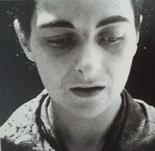
Vieira da Silva was the leading female exponent of the Abstraction Lyrique movement in post-war Europe.
Born in 1908 in Lisbon, from childhood Maria Helena Vieira da Silva showed a keen interest in and aptitude for the fine arts, from the age of 11 studying at the Academia de Belas-Artes. In 1928 she moved to Paris, where she enrolled at the Académie de la Grande Chaumiere studying sculpture with Antoine Bourdelle and Charles Despiau, painting with Othon Friesz, Charles Dufresne and Fernand Leger, and engraving with Stanley William Hayter. In 1930 she married the Hungarian painter Arpad Szenes.
Between 1931 and 1933 da Silva exhibited at the Salon d’Automne and the Salon des Surindépendants, whilst studying at the Académie Ranson. Her first solo exhibition was held in 1933 at Galerie Jeanne Bucher. Although she spent 1935-36 in Lisbon, da Silva continued to exhibit at Galerie Jeanne Bucher until 1940, including participation in the important ‘Ecole de Paris’ show of 1938, and Hilla Rebay acquired a painting for the Guggenheim collection.
During the war, da Silva and her husband, lived in Rio de Janeiro, where she exhibited at the Museum of Fine Arts in 1942. Her first solo show in the U.S. was held at the Marian Willard Gallery in 1946. She also took part in the 1946 Unesco exhibition at the Musée d’Art Moderne in Paris.
Having returned to Paris in 1947, da Silva’s work began to evolve into her now distinctive spatial webs of linear patterns, evoking subliminal matrices in constant flux. She continued to exhibit at the Salon d’Automne (1947-49) and at Galerie Jeanne Bucher and Galerie Pierre. Her work was exhibited in Stockholm (1949), Berlin and Duesseldorf (1950). In 1952 she showed in Zurich, and in the Pittsburgh International at the Carnegie Institute. In 1953 she won a prize at the Sao Paulo Biennale (and again in 1961); exhibited at the Venice Biennale, 1954, also a solo show at Cadby Birch Gallery New York; in 1955, at the Caracas Biennale, and Stedelijk Museum Amsterdam; and she won a Guggenheim Award. In 1966 the French government awarded her the Grand Prix National des Arts and a retrospective was held at the Musée Nationale d’Art Moderne. She went on to exhibit extensively around the world. More recently in 2007 a retrospective was held at the Museum of Modern Art in Sao Paulo.
The artist is represented in numerous museums of Modern Art worldwide.